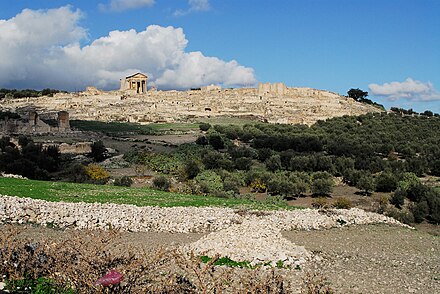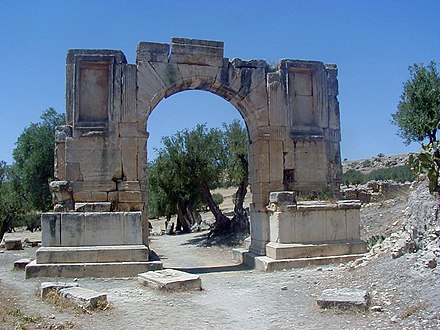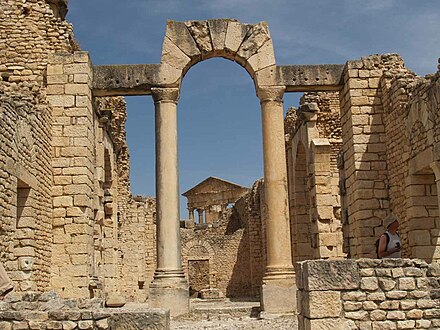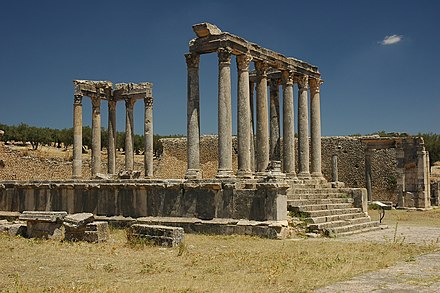Dougga - archaeological site in Tunisia
 Dougga (dead link: January 2023) is a small town in the north of Tunisia that holds the extensive ruins of a Roman town, set on a hilltop, overlooking surrounding valleys with olive plantations, featured on the UNESCO World Heritage list. It also has several other monuments dating from pre-Roman times. Plan to spend about 2 hours here, and if you have a car, couple it with trips to surrounding areas (ask the security guard at the ticket office for recommendations).
Dougga (dead link: January 2023) is a small town in the north of Tunisia that holds the extensive ruins of a Roman town, set on a hilltop, overlooking surrounding valleys with olive plantations, featured on the UNESCO World Heritage list. It also has several other monuments dating from pre-Roman times. Plan to spend about 2 hours here, and if you have a car, couple it with trips to surrounding areas (ask the security guard at the ticket office for recommendations).
Understand
The road to Dougga passes through beautiful rural and scenic landscape. Unlike Roman ruins in Carthage or even in European towns where one or two remaining monuments are isolated in the middle of a modern city, at Dougga, the entire town is preserved, even the Roman streets. Without the barriers and the flocks of tourists, one can take one's time to climb in and out of houses and tunnels, temples and the theatres.
 As with other sites in Tunis, Dougga's history is not limited to only the Roman period. One finds an old Punic temple here with a cleansing bath and walls from the Phoenician period, which was later transformed and reused by the Romans, and thus has Roman pillars. There is also an obvious funerary monument, the Mausoleum of Ateban, dating to 2nd century BCE, one of three examples of royal Numidian architecture. Its inscription is housed in the British Museum, and the Punic-Libyan bilingual inscription was used to translate Libyan script.
As with other sites in Tunis, Dougga's history is not limited to only the Roman period. One finds an old Punic temple here with a cleansing bath and walls from the Phoenician period, which was later transformed and reused by the Romans, and thus has Roman pillars. There is also an obvious funerary monument, the Mausoleum of Ateban, dating to 2nd century BCE, one of three examples of royal Numidian architecture. Its inscription is housed in the British Museum, and the Punic-Libyan bilingual inscription was used to translate Libyan script.
Get in
Get a bus (at least two hours) or louage (80 minutes) to Teboursouk (pronounced Tebsook) from Bab Saadoune louage/bus station (Gare de Routiere Nord) in Tunis. A taxi will take you the short distance to Dougga and then pick you up again at an arranged time. Louage drivers often ring ahead to alert the taxi that a tourist is arriving. It's very convenient and quick but 15-20 DT for only a short distance. If you can't manage to get the price down, remember that Dougga is a memorable place to visit and well worth the money. As of July 2016, there was only one, extremely busy, taxi in Teboursouk that also served as the local bus, so arguing with the driver over the price was pointless.
Use return taxi trip to get to Teboursouk because there will almost certainly be no taxis waiting to pick up passengers leaving Dougga (as it is in the middle of nowhere).
If driving, clear sign posts pointing to the Ruins of Dougga can be followed from Tebersouk.
You could also go as part of an organised tour from Tunis.
Get around
Light sandals might not be the best footwear as the paths are, for the most part, cobbled and can be reasonably steep in places.
See
There are lots of buildings still partially standing. There are also few restrictions as to where you can walk. The following is a suggested route to visit.
Entry is 7 DT plus 1 DT for photography (as of 2018).
- Theater. Built in 168 or 169 CE, is one of the best preserved examples in Roman Africa. It could seat 3500 spectators, and is the first thing one sees on entering the site. From here continue on to the capitol, which has great monolithic columns that cannot be missed.
- Roads.. On the main roads (the broad road to Carthage for example), one can see cut outs for horses not to slip, and holes in the remaining door ways to tie the horses to. Under the roads are the Roman sewers various stones on the main road can be lifted up to let the water out in times of flooding.

- Mosque.. Tiny building with Roman columns in the interior to the left of the capitol when coming from the theatre.
- Marketplace.. Note the marks in the floor where the shop doors used to go.
- Square of the Rose of the Winds.. Look out for the markings on the floor with the 12 winds especially the winds bringing rain from the north.
- The Capitol.. A Roman temple from the 2nd century CE, principally dedicated to Rome's protective triad: Jupiter Optimus Maximus, Juno Regina et Minerva Augusta. Located next to the marketplace and the forum.
- Forum.. Note the statue with the images of four gods on two sides.
- The arch of Alexander Septimius.. Can be seen from far as it is well preserved. On the road towards Theveste, in Algeria (300km).

- The temple of Caelaestis.. A little way off, through a grove of olive trees, and there is a sign pointing the way. It is dedicated to Juno Caelestis, the successor of the Punic god Tanit. Its well-preserved temenos is demarcated by a Phoenician wall, a large section of which has been very well preserved. The interior has Roman columns. On the right side is a small pit used for purification in Punic times.
- Dar Lacheb.. Back on the main road to Carthage is a sanctuary, a temple, a gymnasium? A perfectly preserved door in any case! Two stretches of grass on the inside of this area.

- Antonian Baths.. Three rooms for hot, warm and cold baths. In the center of the city area and was used in winter. Two other baths exist, one outside the city center for the summer. Pass through the tunnels where the slaves used to heat the water to get to the three baths. From the room for rest with the metal grids on the floor and the mosaics, climb up the steep steps to get back to the Capitol.

- Brothel.. Facing the valley, somewhat halfway between Dar Lacheb and the Mausoleum of Ateban, is the brothel many small chambers around a main court. You can get to it by passing through the smaller theatre that is just below the area towards the valley, upon exiting the steps.
- Mausoleum of Ateban..
- Septimius Severus's arch.. From the brothel, continue back towards the main exit and you'll reach the arch of Septimius Severus two stumps left, but majestic. On the road that leads towards Carthage (120km).

Do
Take lots of photographs, wander amongst the olive groves, sit and take in the majesty of the place.
Buy
No facilities on site. Don't be surprised if a local farmer/shepherd tries to sell you Roman 'artifacts'.
Eat
Small shady area with tables where you can buy cold drinks, snacks, postcards and use the toilets.
There is also a restaurant just below the south entrance that offers a single option: a prix-fixe meal (91d meal for 2, Feb. 2019) of soup, salad, and couscous. Expensive by local standards but tasty and a nice environment. The meal takes approximately an hour.
Drink
Make sure you have a supply of water but you can buy it - and other drinks - on site. If buying from the local town make sure you get it from a reputable shop - street vendors have been known to refill empty bottled water containers with the local tap variety.
Sleep
One hotel in the town a few miles away.
Go next
Dougga
Date Time:Please wait...Timezone:Africa/TunisCoordinates:36.42, 9.22
Teboursouk
2nd-order administrative division
Béja Governorate
Primary administrative division
